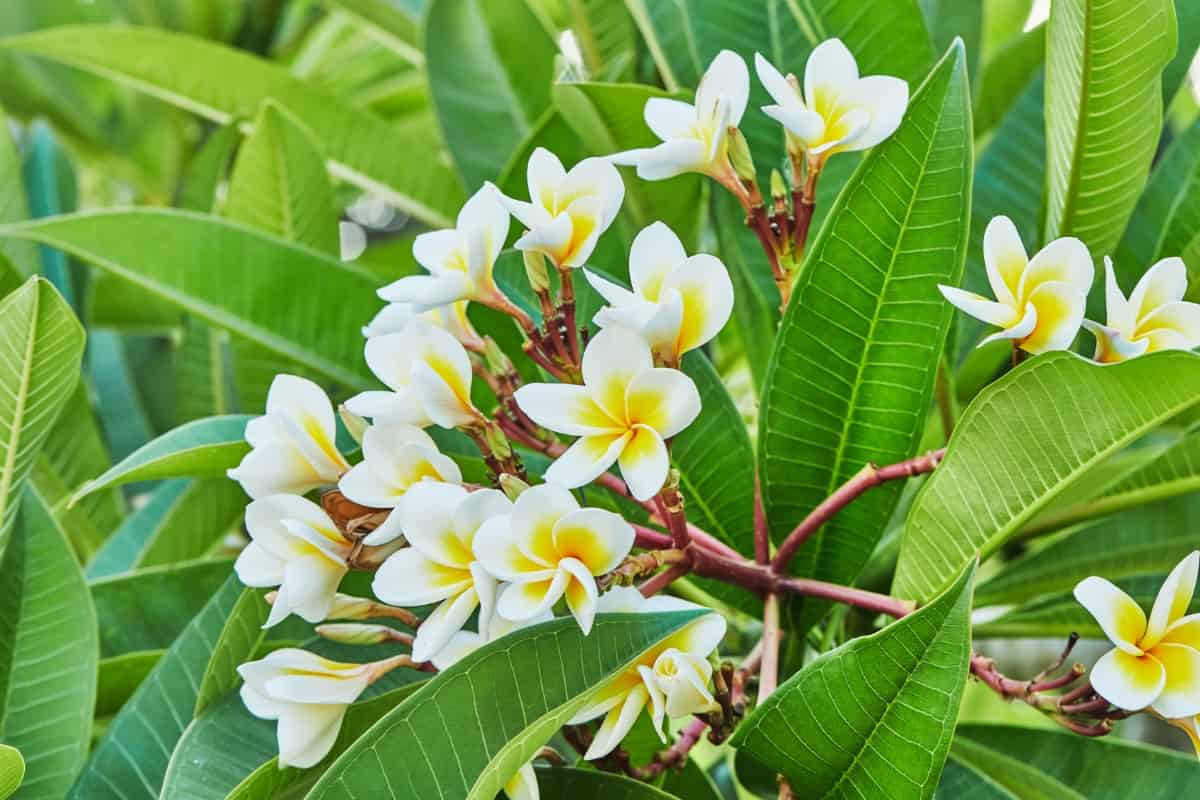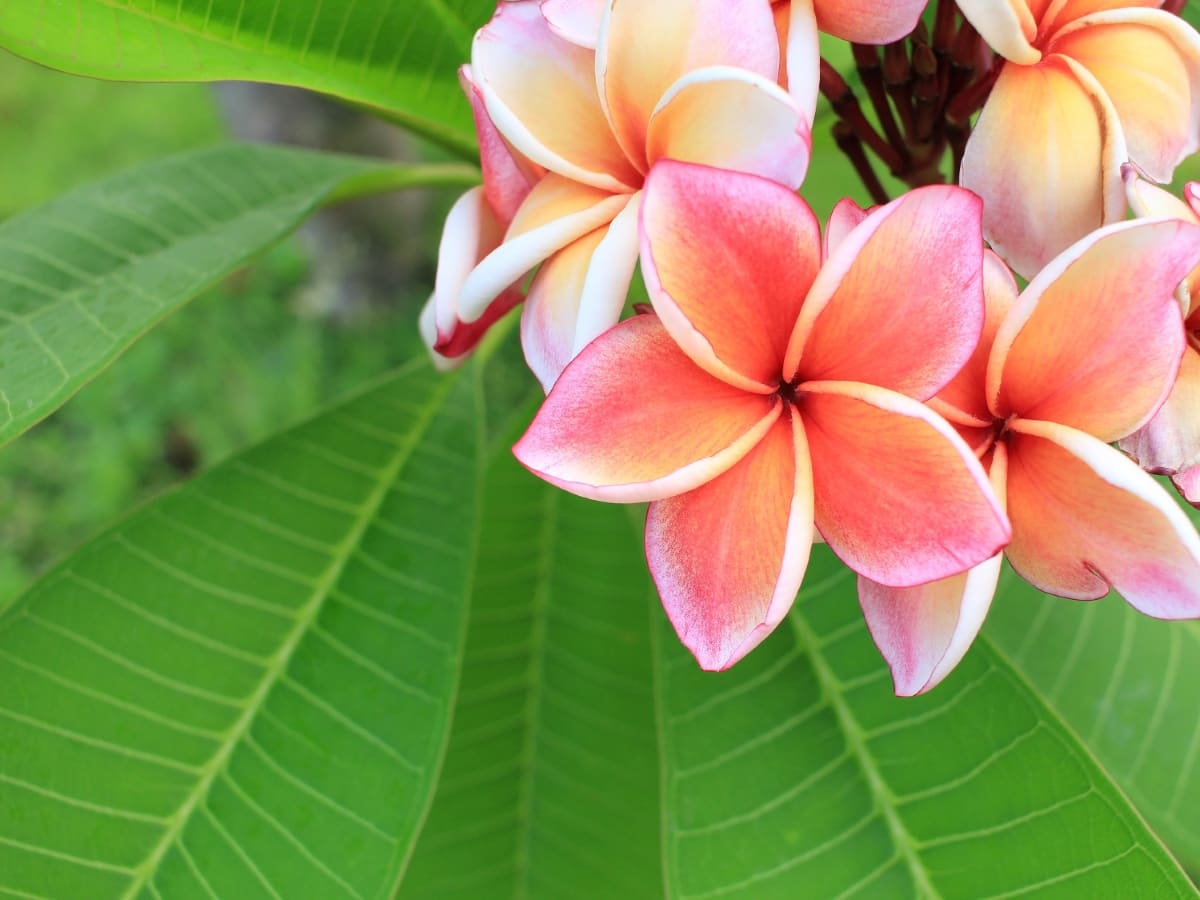Plumeria plants, renowned for their vibrant and fragrant blossoms, boast a diverse array of varieties, each with distinctive features and characteristics. This visual guide explores the captivating world of Plumeria, presenting a curated collection of ten unique species. Each variety showcases a blend of mesmerizing hues and shapes. Delve into the enchanting realms of Plumeria, each offering a visual spectacle.

Different Varieties of Plumeria Plants
Plumeria Obtusifolia
Plumeria Obtusifolia, commonly known as “Singapore White” or “White Frangipani,” is celebrated for its elegant and pristine appearance. This evergreen shrub or small tree showcases glossy, dark green leaves and produces stunning clusters of fragrant, pure white flowers with a yellow center.
The petals are distinctively rounded, contributing to its name, “Obtusifolia,” emphasizing the obtuse shape of the floral lobes. With a compact and bushy growth, this Plumeria variety is well-suited for gardens and containers, thriving in warm climates. Its simplicity and timeless beauty make Plumeria Obtusifolia a favorite among enthusiasts, symbolizing purity and grace in tropical landscapes.
Plumeria Acutifolia
Plumeria Acutifolia, commonly referred to as “Pagoda Tree” or “Temple Tree,” is renowned for its striking and fragrant blooms. Native to Mexico, Central America, and Venezuela, this deciduous shrub or small tree features distinctive leathery leaves and clusters of showy flowers. The blooms, available in various colors including pink, red, and yellow, often possess a pronounced sweet fragrance.
The name “Acutifolia” is derived from the pointed or acute tips of its leaves. Plumeria Acutifolia holds cultural significance in various regions and is often associated with spirituality and ceremonial practices. Its beauty and symbolism make it a cherished addition to gardens, especially in tropical and subtropical climates where it thrives, adding an enchanting touch to the landscape.
Plumeria Pudica
Plumeria Pudica, commonly known as “Bridal Bouquet” or “Fiddle Leaf Plumeria,” is a unique and graceful member of the Plumeria family. Native to Panama and Colombia, this evergreen shrub stands out with its elongated, lance-shaped leaves and clusters of fragrant white flowers. The name “Pudica” is derived from the Latin word for modest or bashful, reflecting the plant’s shy nature as the leaves tend to fold upward at night or during inclement weather.
The pristine white flowers, often tinged with yellow at the center, emit a sweet fragrance, earning it the moniker “Bridal Bouquet.” Plumeria Pudica’s distinctive appearance and delightful scent make it sought-after for gardens and landscapes, adding an air of elegance and charm wherever it blooms.
Plumeria Alba
Plumeria Alba, commonly known as “White Frangipani” or “Pigeon Wood,” is a captivating member of the Plumeria family renowned for its enchanting, pure white blooms. Native to the Caribbean and Central America, this deciduous shrub or small tree features leathery, elliptical leaves and produces clusters of fragrant flowers with a yellow center.
In case you missed it: Plumeria Cutting Propagation: Growing in the Ground, Pots, Indoors, and Water

The name “Alba” refers to the pristine white color of its blooms, symbolizing purity and serenity. With a sweet and lingering fragrance, Plumeria Alba is a favorite in tropical gardens and landscapes, where its elegant appearance and aromatic allure create a serene and inviting atmosphere. The simplicity and timeless beauty of Plumeria Alba make it a cherished addition, evoking a sense of tranquility and tropical splendor.
Plumeria Rubra
Plumeria Rubra, often referred to as “Red Frangipani” or “Common Frangipani,” is a captivating tropical plant celebrated for its vibrant and colorful blossoms. Native to Mexico, Venezuela, and Central America, this deciduous shrub or small tree features large, leathery leaves and clusters of fragrant flowers that come in a spectrum of colors of pink, red, and yellow.
In case you missed it: Best Plumeria Fertilizer: Organic, NPK, Slow-Release, and Water-Soluble

The name “Rubra” emphasizes the radiant red hues commonly found in its blossoms. Plumeria Rubra holds cultural significance in various regions, often associated with love, beauty, and spirituality. Its striking appearance and sweet fragrance make it popular for gardens and landscapes in tropical and subtropical climates. It adds a burst of color and an exotic beauty to outdoor spaces.
Plumeria Obovata
Plumeria Obovata, known as the “Obovate-leaved Frangipani,” is a distinctive member of the Plumeria family characterized by its unique leaf shape and elegant appearance. Native to Southeast Asia, this deciduous shrub or small tree features elongated, obovate leaves with pointed tips and clusters of fragrant flowers.
The name “Obovata” is derived from the obovate shape of its leaves, which are wider towards the apex and narrower towards the base. The blooms, often in shades of pink and white, add to the overall charm of this Plumeria variety. Plumeria Obovata’s aesthetic appeal and unusual foliage make it sought-after for gardens and landscapes, providing a touch of exotic beauty and botanical intrigue.
Plumeria Oblonga
Plumeria Oblonga, recognized as the “Oblong-leaved Frangipani,” stands out among its counterparts with its distinctive oblong-shaped leaves and charming blossoms. Native to Southeast Asia, this deciduous shrub or small tree showcases glossy, elongated leaves and clusters of fragrant flowers.
The name “Oblonga” is derived from the oblong shape of its leaves, adding a unique touch to its overall appearance. The flowers, often displaying hues of pink and white, contribute to the plant’s allure. Plumeria Oblonga is a captivating addition to gardens and landscapes, offering a blend of unusual foliage and delightful blooms. Its aesthetic appeal and tropical charm make it a sought-after choice for enthusiasts looking to add a touch of botanical uniqueness to their outdoor spaces.
Plumeria Obtusa
Plumeria Obtusa, commonly known as the “Singapore White” or “White Frangipani,” captivates with its elegant appearance and pristine blossoms. Originating from the Caribbean and Central America, this evergreen shrub or small tree features glossy, dark green leaves and produces clusters of fragrant, pure white flowers with a yellow center.
The name “Obtusa” highlights the obtuse shape of the floral lobes, contributing to its distinctiveness. Plumeria Obtusa’s compact growth habit and timeless beauty make it a favorite for gardens and containers in warm climates. Its symbolism of purity and grace, coupled with a sweet fragrance, enhances the overall appeal of this Plumeria variety, making it a cherished addition to tropical landscapes.
Plumeria Velutina
Plumeria Velutina, known as the “Mayo” or “Frangipani,” is a captivating variety distinguished by its velvety-textured leaves and vibrant blossoms. Native to Colombia and Venezuela, this deciduous shrub or small tree showcases large, ovate leaves and clusters of fragrant flowers in pink, red, or orange shades. The name “Velutina” references the velvety texture of the leaves, adding a tactile dimension to its visual charm.
Plumeria Velutina is celebrated for its striking appearance and sweet fragrance, making it a popular option for gardens and landscapes in tropical and subtropical regions. Its unique foliage and colorful blooms contribute to a sense of tropical splendor, creating an inviting and enchanting atmosphere in outdoor spaces.
Plumeria Obliqua
It is a tropical tree admired for its fragrant, star-shaped flowers. Native to Southeast Asia, it graces gardens with its elegant appearance and distinctive fragrance. The tree reaches heights of up to 8 meters, displaying glossy, leathery leaves that complement its white or pale pink blossoms.
In case you missed it: The Best Fertilizer for Frangipani/Plumeria: When and How to Apply

Plumeria obliqua thrives in well-drained soil and tropical climates, requiring ample sunlight to bloom prolifically. Cultivated for its aesthetic appeal and aromatic allure, this species has cultural significance in various traditions. Its enchanting presence makes it a sought-after ornamental plant, adding tropical charm to landscapes and gardens worldwide.
Conclusion
In conclusion, exploring the diverse varieties of Plumeria plants offers a visual feast of nature’s beauty. From vibrant hues to unique shapes, each variety showcases the botanical richness within the Plumeria genus. Whether seeking bold colors or subtle elegance, the visual guide serves as an inspiration for enthusiasts and cultivators alike. Embracing the spectrum of Plumeria variations enhances appreciation for these enchanting tropical flowers, inviting us to marvel at the wonders of plant diversity and the artistry of nature.
- Feed Your Flock for Less: Top 10 Tips to Save on Chicken Feed
- Ultimate Guide to Ossabaw Island Hog: Breeding, Raising, Diet, and Care
- Hatching Answers: The Top 10 Reasons Your Chickens Aren’t Laying Eggs
- Eggs and Economics: Breaking Down the Cost of Raising Backyard Chickens
- Defend Your Greens: Proven Methods to Keep Iguanas Out of Your Garden
- Ultimate Guide to Cinnamon Queen Chicken: A Comprehensive Guide for Beginners
- Ultimate Guide to California Tan Chicken: Breeding, Raising, Diet, Egg-Production and Care
- Ultimate Guide to Marsh Daisy Chicken: Breeding, Raising, Diet, and Care
- 10 Types of Chicken Farming Businesses You Can Start for Profits